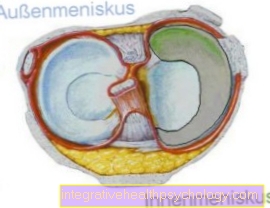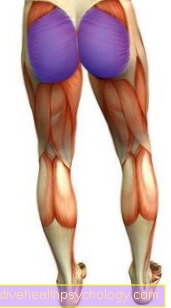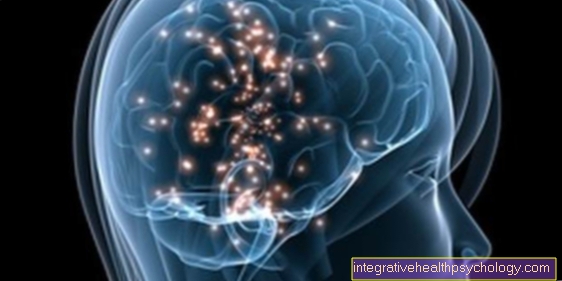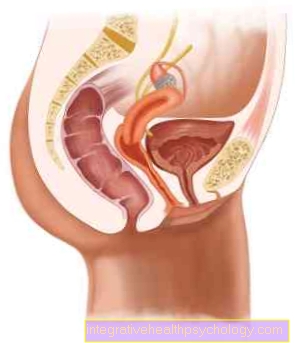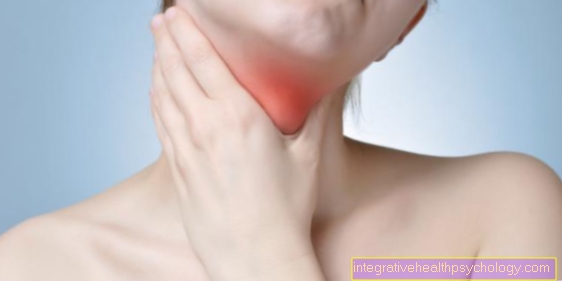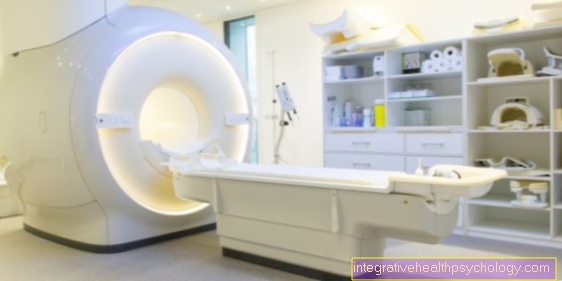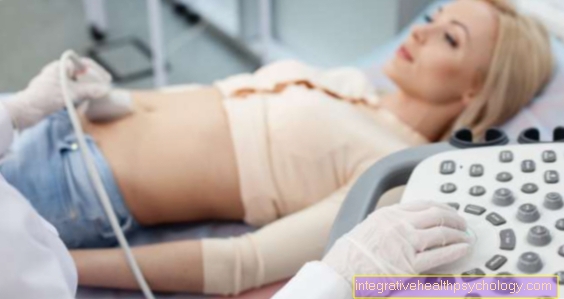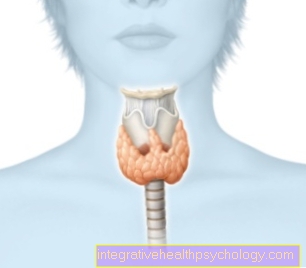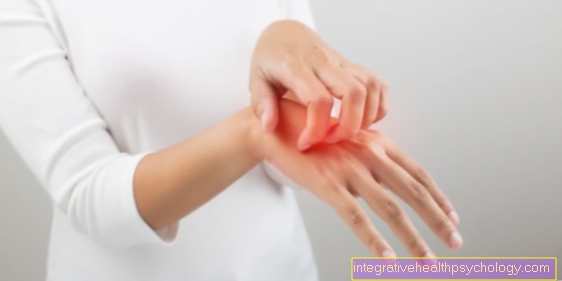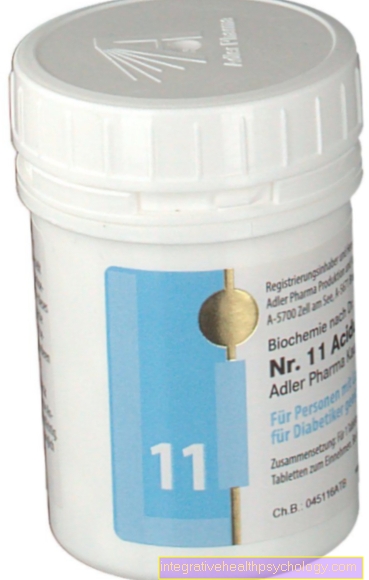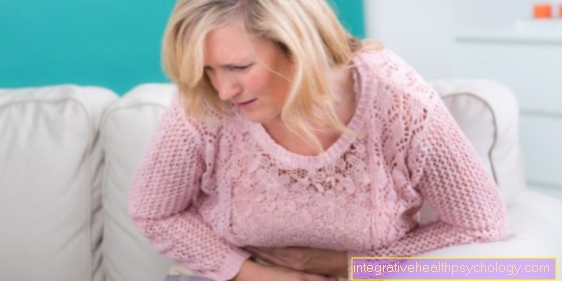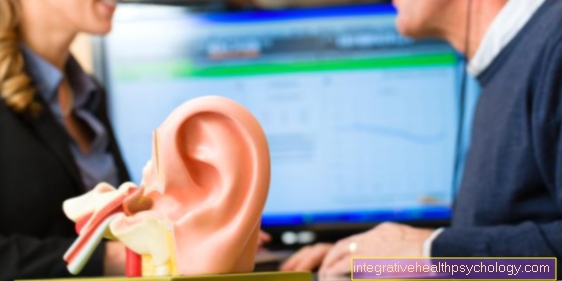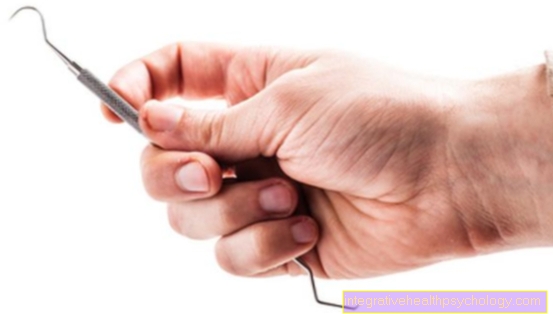Bowel pain
definition
Pain in the abdomen, including the gastrointestinal tract, can have many different facets.
The cause does not necessarily have to be traced back to the intestine, because some other causes can also cause the abdominal discomfort.
Specifically, intestinal pain, or better abdominal pain, can come in different pain qualities. It can be explicitly said that general abdominal pain can never be traced back exclusively to the intestine, which does not mean that it can still come from the intestine.
The innervation of the intestine, which is characterized by bowel movements, is controlled by the so-called autonomous nervous system, which is divided into the sympathetic and parasympathetic nervous systems. There is no sensitive innervation in the intestine, i.e. a direct pain sensation with localization is not possible.
Any bowel pain initially comes as stomach pain.

Causes of intestinal pain
For a simpler structure, it is advisable to break down the various causes of abdominal or intestinal pain based on their pain qualities.
On the one hand there is the colicky pain that can occur with urinary stones or a bile duct obstruction. The pain manifests itself in short successive episodes of extremely painful intensity.
If there is persistent pain that increases in waves, the cause may be peritonitis or an inflammation of an abdominal organ, for example inflammation of the pancreas (pancreatitis), inflammation of the gallbladder (cholecystitis) or inflammation of the appendix (appendicitis) ).
If a total pain intensity peak occurs with a subsequent decrease in pain, a hollow organ such as the intestine may have breached.
Another cause that is associated with a rather diffuse pain is the intestinal obstruction. Diffuse is to be understood here as meaning that the intestinal obstruction can have various causes, such as cancer or an inguinal hernia, which is difficult to differentiate due to the different pain sensations of the individual patient. If pain on the left side of the lower abdomen occurs, for example associated with fever, so-called sigmoid diverticulitis can be the cause. Here, protuberances of the intestinal mucosa become inflamed, most often located in the sigmoid colon, the last part of the large intestine.
Colon cancer pain
The tricky thing about colon cancer, like most types of cancer, is that it often goes unnoticed and continues to grow before symptoms appear. For these reasons, a colon cancer screening examination for every adult from the age of 55 is covered by the statutory health insurance.
The pain caused by colon cancer is often a sign of advanced disease. In fact, early symptoms are rarely or not at all. Colon cancer often becomes noticeable by changes in bowel movements in the form of constipation or by blood drainage during or after a bowel movement.
This bleeding can be visible or hidden, the medical professional uses the word "occult" for this, if blood can only be detected in small amounts by special tests. Weight loss, a drop in performance or occasional fever can also be the cause.
You might also be interested in: Colon cancer symptoms
Book pain after removal of the uterus
Removal of the uterus can be necessary for a variety of reasons. Their anatomical position between the urinary bladder and rectum makes removal very difficult and therefore belongs in experienced hands.
In general, it can be stated that all surgical interventions on abdominal organs can be associated with complications. Specifically for intestinal pain after a hysterectomy, a possible complication could result in constipation or an intestinal obstruction, which is associated with abdominal pain. Complications such as pain are also possible if the intestine is injured during surgery.
If the uterus was removed because of a cancer that appeared to be extensive, possibly encompassing neighboring structures such as the rectum, an intestinal resection is required. The affected piece of intestine is removed and the ends are tied together again. Complications can also become noticeable here as pain if, for example, the sutured area is not well supplied with blood and therefore does not grow together well.
Abdominal pain from stress
Stress-related intestinal pain, for example, suggests irritable bowel syndrome. This is a very common phenomenon from which almost every second patient with gastrointestinal complaints suffers. There are unspecific changes in bowel movements, resulting in diarrhea or constipation, accompanied by abdominal pain.
Stress in general can make gastrointestinal complaints worse. There is an increased motor bowel activity. This irritable bowel syndrome does not necessarily have to be caused by stress. This can also be caused by an infection of the intestine.
The editors also recommend: Abdominal pain with stress
Abdominal pain from adhesions
Adhesions in the gastrointestinal tract can have causes such as inflammation, infections or even previous operations.
Everywhere where the body fights infections, inflammatory cells settle and form a kind of scar structure after the inflammation has healed.
The most common are adhesions after abdominal surgery, which can lead to scarred adhesions, which can, for example, cause an intestinal obstruction. The moving intestine then faces an obstacle in the form of adhesions and can hinder the further transport of the food pulp to be digested.
Pain would then be caused by a possible intestinal obstruction, accompanied by nausea and vomiting as well as stool and wind.
Read more on this topic at: Adhesions in the abdomen
Right-sided abdominal pain
The more precise naming of the region of the agonizing pain often helps the examiner to make a suspected diagnosis. If pain occurs in the right half of the abdomen, the cause may be, for example, inflammation of the appendix (appendicitis).
Read more on the topic: Symptoms of appendicitis
The sensation of pain often begins at the level of the navel and then moves to the right lower abdomen. Various defined points are then available to the examiner for examination.
Other additional complaints can include nausea and vomiting, a lack of appetite and / or wind and bowel movements.
A fever can also occur. Another possible cause of right-sided abdominal pain is inflammation of the last part of the small intestine.
This region can be affected in inflammatory bowel disease such as Crohn's disease.
Inflamed wall protuberances of the appendix (cecum diverticulitis) can also lead to pain in the right lower abdomen. However, these wall protuberances occur more frequently in the so-called sigmoid colon in the left lower abdomen.
You might also be interested in: Abdominal pain on the right side
Left side abdominal pain
Left-sided pain is most often shown by what is known as sigmoid diverticulitis.
The increased pressure in the intestinal cavity leads to the formation of protuberances in the intestinal mucosa.
The reasons for this are a low-fiber diet, constipation and lack of exercise.
The protuberances become a problem if they become inflamed due to the fact that the stool is prevented from moving on. The pain is then increasingly localized in the left lower abdomen and is usually associated with a slightly increased fever.
In some cases, they also show up repeatedly and also in connection with changes in bowel movements in the form of constipation or diarrhea. Furthermore, there may be increased flatulence, nausea and vomiting and defensive tension in the abdomen.
Read more on the topic: Left side abdominal pain
Abdominal pain on both sides
Bilateral abdominal pain is initially not as easy to interpret as directly localizable abdominal pain.
If pain occurs in the upper area of the abdomen and it radiates in a belt-shaped manner into the back, there may be an inflammation of the pancreas. A bowel obstruction can also be painful on both sides.
Furthermore, diseases of the urinary tract, such as renal colic or even cystitis, can be the cause of the pain on both sides.
Explicitly in women, for example, burst ovarian cysts or an ovarian inflammation may be present. In men, a so-called testicular torsion, a twisting of the testicle, can cause pain on both sides in the lower abdomen.
The causes are varied and do not always have to be located exactly on both sides of the stomach, the causes mentioned only show possibilities.
Read more on the topic: Symptoms of inflammation of the pancreas
Diagnosis of intestinal pain
In addition to a detailed anamnesis and physical examination, some aids such as an ultrasound device are also suitable for making a diagnosis.
This can be used to detect the first signs of inflammation, such as fluid build-up.
In addition, clinical pictures such as appendicitis can be detected. The so-called digital rectal examination is urgently required for the physical examination.
The doctor examines the patient's rectum for resistance or blood. As a non-invasive means, conventional x-rays or computed tomography can be groundbreaking.
In the case of stool irregularities and acute pain, a colonoscopy should initially be avoided, as the risk of a bowel perforation is too high. This should be used in the non-inflammatory interval.
Accompanying symptoms with abdominal pain
Accompanying symptoms of abdominal pain can be as varied as their causes. After determining the quality of the pain and the localization of the pain, the physical examination in the form of vital signs (pulse, blood pressure) and temperature can be helpful.
Fever usually manifests itself in an increase by a pronounced feeling of cold and in a decrease by increased sweating.
In addition, nausea and vomiting can occur. A defensive tension in the abdomen usually arises when the disease is acute and should always be perceived as a warning signal. Diarrhea or constipation are often associated with abdominal pain and, in their respective forms, can be stressful for those affected.
Vomiting is reported as an accompanying symptom of the intestinal obstruction. If the food pulp is prevented from passing through the gastrointestinal tract, it comes to a backlog and finally to vomiting. This is definitely the most unpleasant of the symptoms.
Diarrhea as an accompanying symptom
Diarrhea, also known as diarrhea in medical jargon, can occur in conjunction with pain in the gastrointestinal tract.
First of all, the definition is groundbreaking, because only a liquid stool is not yet referred to as diarrhea.
If one of the following criteria is met, one speaks of diarrhea: increased bowel movements, more than 3 times a day, reduction in stool consistency with more than three quarters of water or more than 200-250g per day of unformed stool.
In the acute case of pain with accompanying diarrhea, it is important to pay close attention to the color, smell and any additions of blood. This information can be indicative of the cause.
You might also be interested in: Abdominal pain and diarrhea
Flatulence as an accompanying symptom
Flatulence as a cause of abdominal pain is not that rare.
After consuming particularly flatulent foods such as cabbage, onions or legumes, sensitive people can also complain of accompanying pain. In people with a lactose intolerance, flatulence (= intestinal winds, gas) in combination with abdominal cramps and diarrhea are also possible after consuming dairy products.
In the case of an intestinal obstruction, those affected can initially complain of a draft, later this turns into a stool and wind behavior. It is important not to hold back the winds, but to give them space, which is often perceived as relieving.
The editors also recommend: Abdominal pain from gas
Back pain as an accompanying symptom
A large number of back pain cannot initially be traced back to the intestine, but rather is caused by tension in the muscles or blockages in the skeletal area.
In order to recognize avoidable dangerous processes, a careful anamnesis of the attending physician is required, who can rule out the worst cases or initiate countermeasures.
Abdominal pain in general can, in terms of its pain progression and pain quality, migrate to the back and exacerbate a certain level of suffering for the person concerned. The pain of a pancreatitis in particular is often described by the patient as belt-shaped, wandering into the back. This inflammation is very painful and requires close-knit, often in-patient therapy.
Read more on the topic: When back pain and abdominal pain occur together
Nausea as an accompanying symptom
Nausea, as one of the most important accompanying symptoms of diseases of the gastrointestinal tract, can often appear as one of the first symptoms that troubles the person concerned.
In some cases, vomiting occurs in addition to nausea, which often significantly increases the feeling of illness. Even patients with severe abdominal or bowel pain can experience nausea, which is characteristic.
As a so-called vegetative symptom, nausea shows that the body is in a stressful situation.
For example, if someone suffers from appendicitis, more messenger substances are released which, in addition to pain, can also trigger nausea and vomiting. This is part of the body's general inflammatory response.
Read more on the topic: Bulging pain and nausea
Therapy of intestinal pain
First of all, it can be stated that the symptoms of acute abdominal or intestinal pain should be handed over to a doctor.
There are simply complications, such as intestinal ruptures, which, if detected in time, can cause less damage.
Therapy for intestinal pain in the form of abdominal pain can only be initiated if a specific anamnesis has been made to find out the cause of the pain.
If the person affected suffers from appendicitis, conservative therapy with close monitoring and, if necessary, antibiotic therapy can be helpful.
As a rule, however, it can be said that appendicitis usually justifies surgical therapy.
If the affected person has an intestinal obstruction, it is important to consider whether a conservative or surgical approach should be used. In patients with stable circulation, laxative measures under close monitoring can often be justified. If, however, an adhesion, as it may have developed after a previous operation, is the cause, an operation to restore the intestinal passage should be performed. In general, the cause must be clear before therapy.
In general, you should not be afraid to seek medical advice, because some serious complications can occur with some courses.
One example of this is the so-called mesenteric artery occlusion. Similar to a stroke in the brain, this leads to blood clot-related blockage of important blood vessels supplying the intestine. This is then expressed in a reduced blood flow to the respective section of the intestine. The symptoms are often shown as severe pain, which gets better after a few hours - referred to in medicine as "lazy peace". Then the pain often flares up again. If such symptoms occur, an intestinal operation must be performed immediately, as otherwise serious complications and even death of the person affected can occur.
You might also be interested in: Abdominal Pain - What Should I Do?
Home remedies to fight intestinal pain
Home remedies to combat mild abdominal pain can include warming pillows such as cherry stone pillows.
These can be easily heated in the microwave and can have a soothing effect on stomach pain. In addition, teas and herbal supplements are recommended for anti-spasmodic therapy.
Herbal teas such as peppermint, fennel, caraway or anise tea should be mentioned for this. It can also help to increase the amount you drink, especially if accompanying symptoms such as fever occur.
In addition, some physical exercise may be indicated in the case of slight progress. In addition, a heavy, high-fat diet should be avoided and potentially flatulent foods should be avoided.
In principle, a home remedy-based therapy can always be started with mild complaints, if the pain and complaints worsen or extend, a doctor should always be consulted.
Read more on the topic: Home remedies for abdominal pain
Which drugs work best?
In principle, pain relievers such as ibuprofen or paracetamol that are freely available in stores can be helpful for mild pain relief. The pharmacist can initially provide helpful tips for recommendations.
If the symptoms persist or worsen, the situation becomes acute, you should wait for medical treatment and nothing else should be taken in order not to impair the anamnesis. In the case of acute courses, potent drugs can then bring about an improvement in the pain in a clinical setting.
Duration of complaints
The duration of a symptom with intestinal or abdominal pain is difficult to predict individually. What cannot be repeated often enough, however, is that if the duration of the pain extends longer, it may intensify, the emergency service should be informed.
Prognosis for intestinal pain
An individual prognosis should generally be avoided, as the courses of the individual patients differ considerably. In general, it can be said that with rapid intervention in the pain symptoms and the underlying disease, a longer course with complications can be averted.
Abdominal pain after caesarean section
As mentioned above, abdominal pain may well persist for some time after an abdominal surgery. If it is necessary to perform a caesarean section, for example in the event of a corresponding birth arrest or a child in an impossible position, this can lead to pain in the abdomen.
Explicit pain in the intestine cannot be traced back to it.
Nevertheless, neighboring structures or organs such as the intestine can be unintentionally injured during the operation, so that subsequent pain can be plaguing. Once the cause has been resolved, these can be treated with painkillers.
Read more on the topic: Abdominal pain after a caesarean section
Abdominal pain during your period
A woman's monthly menstrual period is often associated with complaints in the form of abdominal pain. Since the cycle is hormone-controlled and subject to a complex interaction of the individual hormones, even small deviations can lead to complaints.
These can be caused by stress, for example, but also by medication. Furthermore, mechanical contraceptives such as the IUD can cause discomfort during menstruation. Ovarian cysts and fibroids (benign tumors of the uterus that grow in a hormone-dependent manner) can also cause cycle-dependent pain.
You might also be interested in: Pain in the abdomen
Abdominal pain after childbirth
After the birth of a child, which can be done in two ways, vaginally or by caesarean section, irregularities in the gastrointestinal tract can also become noticeable.
Any type of operation can initially mean that the person being operated on can expect stool irregularities. These often take the form of constipation, which can be uncomfortable as stomach pain.
The vaginal birth can also initially cause the mother painful so-called post-contractions. This leads to a contraction of the uterus and thus to cramp-like pain in the abdomen.
Read more on the topic: Abdominal pain after childbirth
Abdominal pain after alcohol
Abdominal pain after drinking alcohol is not an uncommon phenomenon, especially when the consumption has been exaggerated. Even small amounts can cause an overproduction of gastric acid in some and thus cause pain to the person concerned.
After excessive alcohol consumption, inflammation of the pancreas can occur in not so rare cases, which can be accompanied by the belt-shaped pain described above. This picture of pancreatitis should definitely be treated quickly enough by a doctor.
Read more on the topic: Abdominal pain from alcohol
abnormal bowel movements with abdominal pain
In general, bowel movements in conjunction with intestinal pain, better abdominal pain, can be indicative of the diagnosis.
A detailed anamnesis with regard to frequency, color, consistency, any blood and smell can definitely be helpful for the examiner.
A so-called digital rectal examination, the manual examination of the rectum with the finger, can often be informative.
With increased stool and wind retention or diarrhea, certain conclusions can also be drawn for the doctor. The former suggests constipation or intestinal obstruction, the latter can be caused by gastroenteritis, an inflammation of the gastrointestinal tract caused by germs.
Abdominal pain in pregnancy
Intestinal pain, or better abdominal pain, can also occur during pregnancy. The growing child in the mother's womb becomes increasingly demanding in terms of limited space.
As a result, loops of the intestine can be moved or other organs restricted in the blood supply. This can then manifest itself in pain.
In addition, child movements can lead to pain in the womb.
All of these possibilities show how different the causes of stomach pain in pregnant women can be. In principle, accompanying symptoms such as bleeding or excessive pain should make you prick up your ears. It can be said that the pregnant woman should be overly careful and should rather visit her treating doctor more often in order to ward off serious processes that could harm her and the unborn child.
Read more on the topic: Abdominal pain in pregnancy
Abdominal pain after eating
Symptoms of pain in the intestines or abdomen after eating can initially have very banal reasons, such as a feeling of fullness when a meal is too lavish or rich in fat.
Nevertheless, the description of the painful stomach or intestine leads to the assumption of an ulcer disease. If a person is suffering from a gastric ulcer (gastric ulcer), the pain can characteristically occur after eating.
But pain regardless of food intake can also increase the level of suffering. In comparison, the pain of an ulcer in the duodenum is often described as an alleviation of the pain after ingestion of food.
Read more on the topic: Abdominal pain after eating
Abdominal pain when sitting
Abdominal pain that only occurs when sitting, like all other causes, cannot be determined without an appropriate diagnosis.
Those affected with mild progressions often find improvement when the body changes position, but movement can also bring improvement. Basically, no causal diseases are known that only cause abdominal pain when sitting. At most, a muscular cause of the abdominal muscles can be considered, which can arise, for example, during unusual movements or during sport.
You might also be interested in: Abdominal pain while sitting






